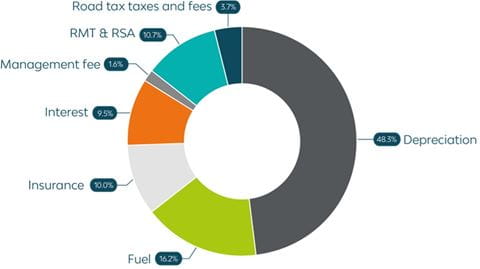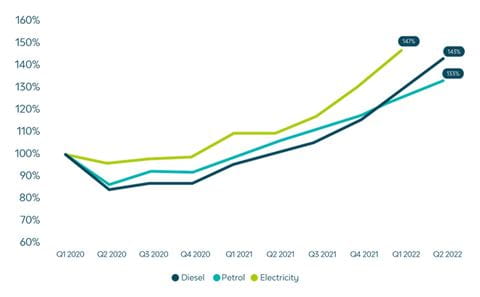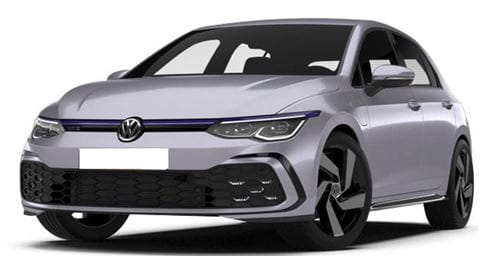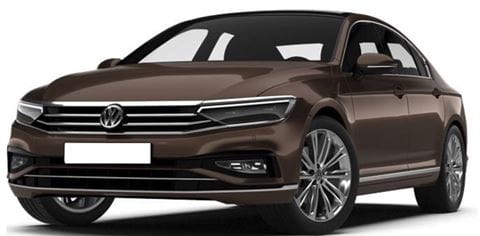
Setting the right lease budget, even in uncertain times
These days, a common question from our international clients is how best to set lease budgets in unpredictable times. Businesses are feeling the impact of increases in vehicle list prices, decreasing OEM discounts and steadily rising inflation – all of which means that some vehicles might no longer fit within your planned lease budget.
Total cost of ownership (TCO)
This blog was originally published as ALD/LeasePlan, now Ayvens Let’s begin by looking at how lease costs are built up. Ayvens’ TCO dashboard shows that, on average, the share of different cost items is as follows[1].

Market developments, Vehicle prices
Our latest trend report, from external data[2], shows an average vehicle catalogue price increase of over 3%^[3] ^during the past 12 months in 11 European countries (although there are, naturally, differences between countries). This is a relatively modest number from the perspective of the general inflation numbers we’ve seen (up to 6%). This can be explained by the fact that vehicles in our analysis fall under the less impacted fuel types (plug-in hybrid and battery electric vehicles (BEVs)) and the less impacted vehicle segments (C, D and E). Hardest hit? Small diesel and, to a lesser extent, small petrol vehicles, as well as the larger SUVs in all fuel types[4].

Vehicle cost is impacted not only by increased catalogue prices but also by lower discounts. Supply shortages are putting pressure on both sides of the equation. Our estimate is that the overall impact on the cost of vehicles is around 8%; namely, 5% from lower discounts and 3% from higher vehicle catalogue prices.
Price insights:
- The average catalogue price increase between April 2021 and April 2022 equals 3.1%
- Core consumer prices in European Union increased 3% in December of 2021 over December 2020
Price methodology Data is based on vehicles that have exactly the same specification over time allowing for accurate monitoring of price development. Countries in scope: AT, BE, CH, CZ, DE, FR, ES, IT, NL, PL, RO (e.g. Germany, Audi A4 Avant 35 TDI S-Tronic).
Potential price effect caused through the introduction of a new model or a change in trim line name is not included.

Fuel Fuel prices have been rising strongly over the past 12 months, pushed by geopolitical turmoil and general inflation. In Q2 of 2021, fuel prices were back at pre-pandemic levels, and they’re now over 30% higher than a year ago.5
Fuel insights Starting from Q4-2020, fuel and electricity prices have been steadily rising Diesel up> 40% over the past 12 months Petrol up > 25% over the past 12 months Electricity up almost 50% over past 12 months
Significant increase in electricity prices in: Norway: (+56%) Spain (+62%) Denmark(+67%) The Netherlands (+101%) This can be explained by the increased demand, inflation, and geopolitical uncertainties.
Impact on TCO So, what does this mean for your lease budgets? When we do the maths, we can see that although fuel accounts for a relatively low share of TCO (16%), the price increase is high: around 20% year on year. This results in a TCO impact of 3.2% (16% * 20%).
Applying the same logic to depreciation, we can see that its share of TCO is much more significant, at 48%. If we include the impact of increasing catalogue prices (+3%) and lower discounts (-5%), we see an 8% impact on depreciation and thus a 3.9% impact on TCO (48% * 3.9%).
Taking into account only depreciation and fuel, therefore, there’s a 7.1% impact on TCO.
For electric vehicles (EVs), the TCO share of electricity is lower, by roughly half, than that of fuel for internal combustion engine (ICE) vehicles. Depreciation, on the other hand, has a higher share for EVs than for ICE vehicles. The TCO market-wide impact is therefore relatively comparable.

Grade I - Volkswagen Golf36 months Year 1: €700, Year 2: €800 48 months Year 1: €600, Year 2: €700 60 months Year 1: €500, Year 2 €600

Grade II - Volkswagen Passat36 months Year 1: €800, Year 2: €900 48 months Year 1: €700, Year 2: €800 60 months Year 1: €600, Year 2 €700

Grade III - BMW 3-series36 months Year 1: €900, Year 2: €1,000 48 months Year 1: €800, Year 2: €900 60 months Year 1: €700, Year 2 €800 *Pricing above for illustrative purposes only
Our top tips
1. Widen your range of vehicle brands In times of supply chain shortages and long delivery times for new vehicles, it makes sense to investigate alternative brands to add to your portfolio. In the past, you might have limited your OEM selection to three brands, to support order consolidation and simplify administrative tasks such as ordering and contracting. Today, however, it may be helpful to widen your policy to allow any model that fits the permitted budget and other restrictions (fuel type, contract length etc.) as long as it’s a comparable vehicle segment. Try looking beyond the usual suspects: new OEMS from China, for example, are today producing some of the most exciting car on the market[6].
2. Consider going electric As our CarCost Index shows, in many countries and vehicle segments BEVs are becoming – or are already – price competitive. Instead of adjusting your lease budgets, see which BEV options already work within your current allowance. And of course BEVs today check a number of other ESG boxes, as switching to electric is one of the easiest ways to cut emissions from your fleet and signal your company’s sustainability credentials.
3. Make longer contracts work for you As we saw in the example above, extending vehicle contract durations might have a positive impact on monthly lease instalments. Of course, the same goes for vehicles in your current fleet, as cars depreciate more at the beginning of the lease period than at the end. While maintenance will go up as the vehicle gets older and the mileage increases, it might still be worth investigating whether extending the current contract could lower your monthly lease instalment – so your costs stay the same or even decrease, and the driver can continue to enjoy their current vehicle.
*Sources:
[1] Average for AE, AT, BE, BR, CH, CZ, DE, DK, ES, FI, FR, GR, HU, IE, IN, IT, LU, MX, NL, NO, PL, PT, RO, RU, SE, SK, TR, UK, US. Passenger cars and vans. All fuel types
[2] Autovista
[3] Data is based on vehicles with exactly the same specifications, allowing for accurate monitoring of price developments over time. Countries in scope: AT, BE, CH, CZ, DE, FR, ES, IT, NL, PL, RO (e.g., Germany, Audi A4 Avant 35 TDI S-Tronic)
[4] Autovista
[5] Countries: AT, BE, CH, DK, ES, FR, DE, IT, NL, PL, PT, UK. Source: Globalpetrolprices.com
[6] https://www.leaseplan.com/en-ix/blog/future/latest-evs-chinese-oems/*



